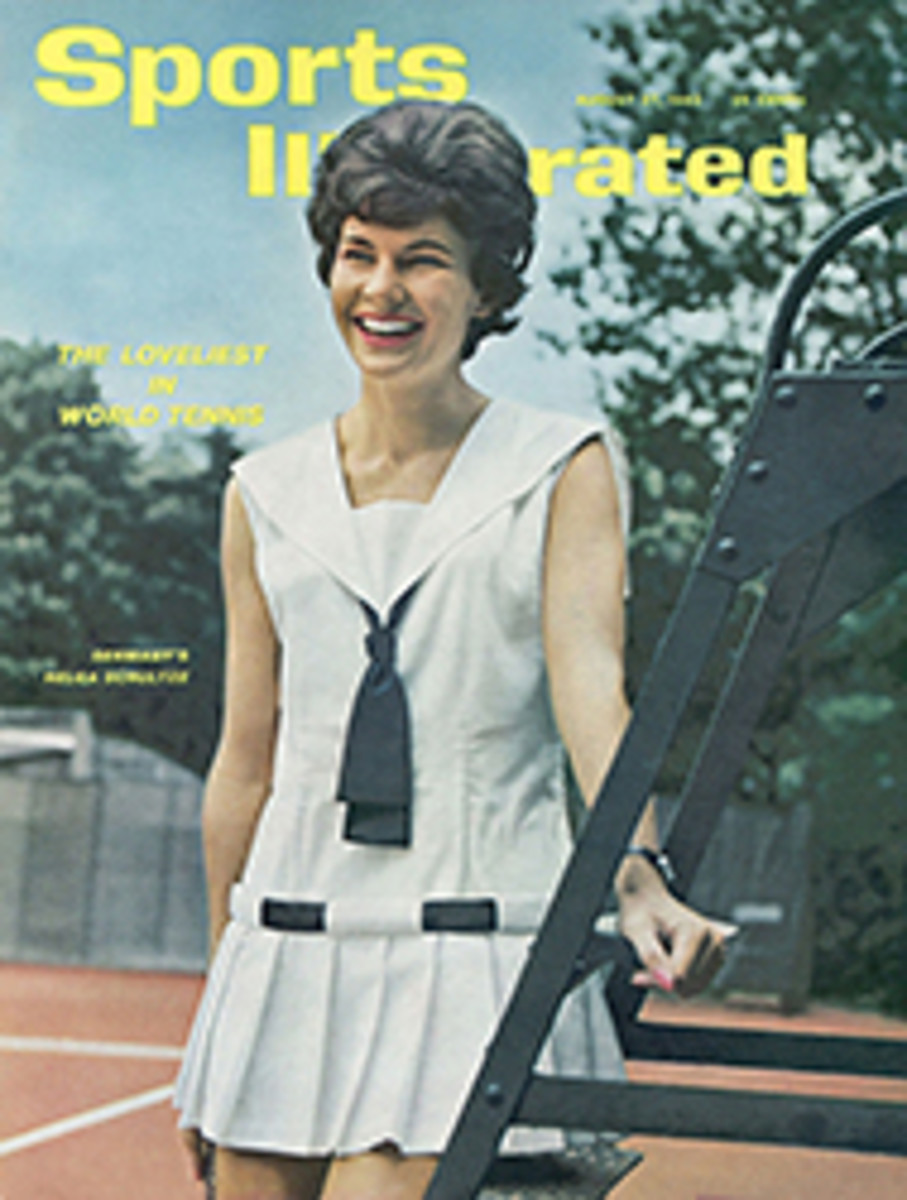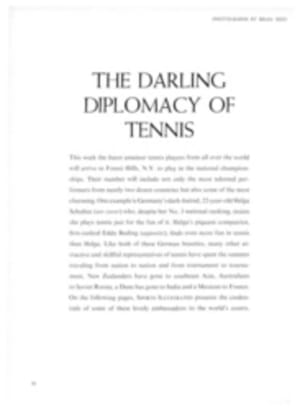
THE DARLING DIPLOMACY OF TENNIS
This week the finest amateur tennis players from all over the world will arrive in Forest Hills, N.Y. to play in the national championships. Their number will include not only the most talented performers from nearly two dozen countries but also some of the most charming. One example is Germany's dark-haired, 22-year-old Helga Schultze (see cover) who, despite her No. 3 national ranking, insists she plays tennis just for the fun of it. Helga's piquant compatriot, first-ranked Edda Buding (opposite), finds even more fun in tennis than Helga. Like both of these German beauties, many other attractive and skillful representatives of tennis have spent the summer traveling from nation to nation and from tournament to tournament. New Zealanders have gone to southeast Asia, Australians to Soviet Russia, a Dane has gone to India and a Mexican to France. On the following pages, SPORTS ILLUSTRATED presents the credentials of some of these lovely ambassadors to the world's courts.
'I TOOK TENNIS...'
Karen Hantze Susman and her husband Rod sat side by side at the luncheon table, eating macaroni salad to keep up their strength. The eastern grass court championships were under way at South Orange, New Jersey; Karen had just defeated Carol Southmayd, and Rod was about to play Clark Graebner. "I like sandwiches real well," said Karen, accommodatingly, starting on a sandwich. No sandwich purveyor was within earshot, but it was like Karen to make the statement in case one might be. The 19-year-old Wimbledon champion is a gentle creature off the tennis court, given to allowing her new husband to finish her sentences and not given to talking with her mouth full. "What kind of court do you like best?" she was asked. Karen waved a hand for time to swallow, and Rod said, "Cement."
"Cement," Karen affirmed, emerging. "And grass, of course, but you prefer what you grew up playing on. If you come from the Midwest, maybe you like clay. And it depends on the kind of game you play, of course."
Karen Hantze was born in San Diego in 1942, an only child whose parents have now been divorced for two years. Like many California children, she was early wrapped up in swimming and tennis. She took up both at the same time—tennis with Eleanor (Teach) Tennant, Maureen Connolly's coach, and swimming with Bill Lucas. "My father was in the Navy with Bill and discovered he was in San Diego when I was 9 or 10," Karen said. "Father thought he'd like him to teach me, so he took me over." In California many 8-year-old swimmers have reputations and records. Lucas told prospect Hantze to swim the length of the pool, and "we were both shocked," Karen recalls, "when I told him, 'I'm sorry I can't quite do that for you now. I can't swim.' "
A year or so later, however, Karen was swimming well enough and playing tennis well enough to have to be told to rest for a year from all competition. And then to choose—tennis or swimming.
"I took tennis," Karen says, "I really don't know why. I must have had a reason. I wish I could remember. I think maybe if I just thought about it I could recall—but I just can't remember."
Whatever the elusive reason, the decision shaped up as a sound one. In 1957, at 14, Karen Hantze won the U.S. girls' (18 and under) singles championship. In 1958 (with Helene Weill) she became girls' doubles champion. In 1959 and 1960 she was both singles and doubles champ. As a senior at Mission Bay High School in San Diego, she achieved No. 2 position on the 1960 Wightman Cup team. Making the cup team was apparently for Karen a point of no return—the point no young champion recognizes but which the observer can put a finger on later and say, "There's where she was hooked." Of tennis before the cup team Karen says, "It was just something to do after school." And afterwards: "Making the Wightman Cup team, that was a big thrill for me. I began working out at night." In 1960 and 1961 she came and saw Wimbledon, and in 1962 she conquered, bringing the English championship back to the United States for the first time since 1958 and becoming the second youngest woman ever to win it (the youngest: Coach Tennant's other pupil, Maureen Connolly).
By 1959 many experts were predicting a spectacular tennis career for Karen Hantze—most, in fact, except old Mercer Beasley, who went sourly on record as sure Karen would never really make it. She was too pretty. She would become "a cover gal, a clothes model, queen of this and that and the belle of the ball"—but never a champ. Karen resisted this particular batch of a pretty girl's temptations, but succumbed to something else. She took to holding hands. In 1959 she met young Rod Susman at Merion. They became inseparable, and certain elements within amateur tennis promptly had a small convulsion and undertook to separate them.
"She was good," Rod said bluntly, "and I was sort of an independent, lowly ranking player—they couldn't have cared less that I was even on the tournament circuit."
"Oh, I don't think that was it," Karen said to this, flustered.
"That certainly was it," Rod said. Karen's husband has the softest-looking brown hair imaginable, which makes it difficult to describe him as "bristling" but, in theory anyway. Rod bristles when he contemplates the efforts of the "certain elements" to break up his romance—efforts that extended even to the cloak-and-dagger point of keeping Karen's off-the-court whereabouts secret. Almost more upsetting to the courting couple was the fatherly advice they both received—Rod's a lot less gentle than Karen's. Karen reacts to questions about it all with a real fright, as though even now she and Rod could be separated, or swooped down upon and their tennis rackets snatched away. She doesn't like to talk about it. "Certain people did do things," she said nervously. "We won't mention any person's name. I mean, they thought they were doing what was right. I mean, I was young, I was 17. But you could come up to this tennis club and see Joe Nobody and Susie Nobody holding hands, or going together, and no one would care, and not that I'm in the limelight or anything, but as soon as they noticed I was interested in anything but tennis...." Her voice trailed off a little. Then, gathering courage, she went on, "Now I wonder how I ever let them do it. It's a natural thing, you don't spend all day looking at a tennis ball. But for some reason on the tennis circuit it's out of place. But it's natural, really."
Karen Susman obviously still suffers from the strain of having been told by an adviser of some importance that it was not permissible to fall in love and that she ought not to see Rod anymore. "And Karen agreed with him," Rod huffs. "Well, I kind of went along with him—no, I didn't," Karen struggles. "I'm polite, that's what it is."
Rod and Karen finally made their way through all this fuzz and were married last September after her third-round defeat in the Forest Hills tournament.
It was a small wedding, in San Antonio. Rod went back to Trinity University and Karen straight to housekeeping.
"We don't really know exactly what we'll do after Rod gets out of school," Karen said. "I think he'd like public relations, something like that, in business. Or just selling. He likes to sell. I think you have to work your way up," she said trustfully. "If I ever decide to go back to school I'd study to be a secondary-school teacher. I'd like to go to California. A lot of the kids there play tennis." For the moment, however, it's back to the house and the cookbooks. "I've got two I use," Karen says. "I traveled so much I never had to cook, but I do all of it now." Her first undertaking was meat loaf. "Really good, hm? It was an awfully rush thing. We were married on a Friday, and we went into Houston Saturday and Sunday for our honeymoon and Sunday night I said, 'Well, it's now or never. Let's have some meat loaf.' "
Karen has no hobbies—no time—but she admits to a suppressed passion for mosaics. "I love mosaic. I'd love to make one of those tables—have you seen them? But Rod won't let me. He doesn't think I'll finish it."
"Karen," Rod said to this, askance, "they might quote that. But how are you going to cart a 50-pound table around the country? What would you do with a 50-pound table?"
Rod's point is well taken, particularly since the Susmans hope to be traveling more, rather than less, for a while. Karen has never done the full tour, and since she has been married she has spent the school year at home, nine months out of 12. When Rod graduates they would like to have a go at the whole thing. "We plan to do it for about a year," Rod says. "If they still have a tour all year round." This will no doubt be all right with Karen, because everything is all right with Karen as long as she is with Rod (early this month she refused an invitation to Russia that could not include him), but she has said, "If you get into a routine of tennis 12 months out of the year, I don't see how you could want to go on playing." Also, Karen is not as strong as some of the beefier young ladies playing tennis. She does not play her best week after week after week. Since her victory at Wimbledon the young champion has been plagued by an injured thumb, and by Australia's Margaret Smith, who seems to have her jinxed; it may not be so much Margaret's game as a relentless stamina that Karen is not always able to match.
Whatever the case there, Karen Hantze Susman is a pretty girl who has won at Wimbledon and can make a good meat loaf. At 19, many girls would be content to sit down and rest on those laurels.
PHOTO
BRIAN SEED
PHOTO
BRIAN SEED
South Africa's Sandra Reynolds Price was a finalist at Wimbledon in 1960, champion of Germany the same year.
PHOTO
BRIAN SEED
Australia's Madonna Schacht (left), a stenographer for a bank in Brisbane, is on her first overseas tour.
PHOTO
BRIAN SEED
Denmark's Inge Overgaard began playing at 13, won Denmark's national junior championship four times.
PHOTO
BRIAN SEED
France's best girl player, Florence de la Courtie (above), got married at the Wimbledon tournament.
PHOTO
JERRY COOKE
California's Karen Hantze Susman, a 19-year-old bride of a year, was the surprise winner at Wimbledon last month.

